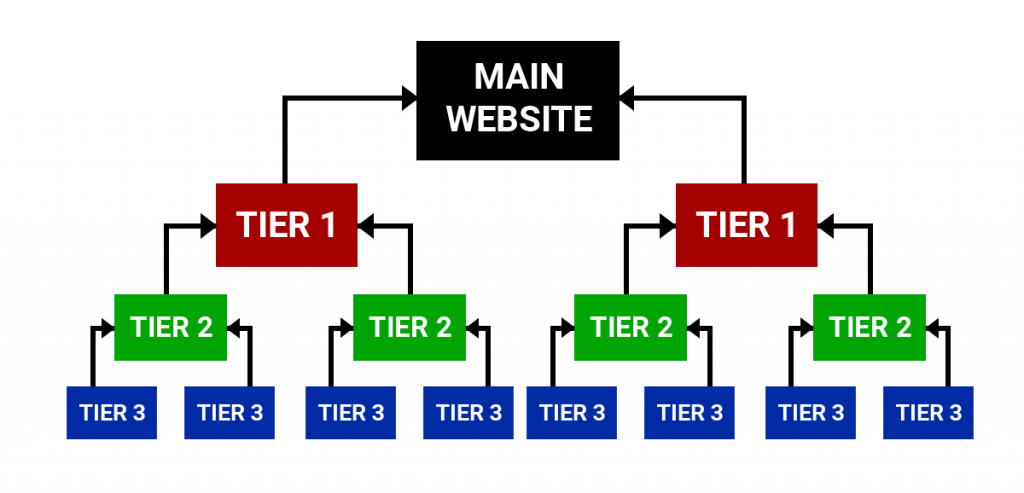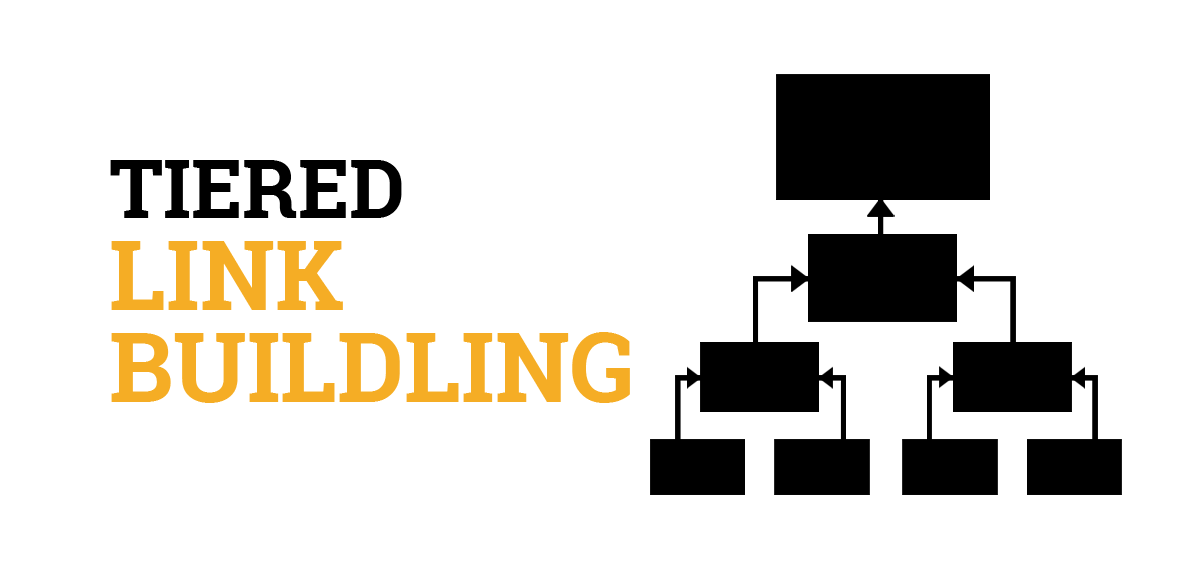In this article, you’ll learn all about tiered link building. Not only will understand various parts of a tiered link building strategy, but you’ll also discover the benefits and risks associated with this type of off-page search engine optimization (SEO).
The ultimate goal here is to help you understand how tiered backlinks work in digital marketing. It also serves as a guide for explaining how different tiers of links improve the domain authority and page authority for your website to help increase the rankings in the search engine results pages (SERPs.)
What Is Tiered Link Building?
Tiered link building is the process of building backlinks from a variety of sources to your website through a tiered system. A proper tiered link building strategy consists of 3 levels where you’re building backlinks to your backlinks for SEO purposes.
The purpose of using tiered backlinks is to pass as much link equity as possible to your main website to increase the PageRank value for SEO while minimizing the risk of creating an unnatural backlink profile.
To explain it more simply, tiered link building is the process of building backlinks to your backlinks. The proper flow of the system looks like this:
- Tier 1 backlinks point to your main website (e.g. homepage or individual web page URL).
- Tier 2 backlinks only point to a tier 1 backlink.
- Tier 3 backlinks only point to a tier 2 backlink.
This tiered linking strategy allows you to send link equity both directly and indirectly to your main website to increase rankings in the SERPs.

Tiered Link Building Strategy
Tier 1 Backlinks
First-tier backlinks are the most important links in a tiered link building strategy because they point directly to your website. Therefore, tier 1 backlinks should be the highest quality links you get so you can pass the most link equity through these backlinks to increase the PageRank value for SEO.
When you’re building first-tier backlinks, you should focus on quality, relevance, and context for each link you acquire for your website. Tier 1 backlinks should also be dofollow backlinks that transfer the most PageRank value. It’s better to have fewer high-quality tier 1 links than more lower-quality backlinks at this level.
Tier 1 backlinks can go directly to your website’s homepage to increase the domain authority or to individual URLs to improve the page authority metrics.
Examples of tier 1 backlinks include:
- Editorial links on high domain authority sites.
- Contextual backlinks on high page authority blog posts.
- .EDU backlinks from colleges and universities.
- .GOV backlinks from local, state, and federal government sites.
See this other page to learn more about tier 1 backlinks.
Tier 2 Backlinks
Second-tier backlinks are the second most important links for tiered link building because these links point to your tier 1 backlinks. As for the quality of tier 2 backlinks, you don’t have to be as strict because they’re not directly sending link equity to your website.
The purpose of second-tier backlinks is to improve the PageRank value of the tier 1 links through a mixture of quality and quantity. Anything that’s not pure spam is typically good enough for tier 2 link building. And they can be a mixture of dofollow and nofollow links.
The goal is the build second-tier backlinks at a higher scale than your tier 1 backlinks which often means you have to lower the quality level to get more backlinks created in a shorter amount of time. However, that doesn’t mean you can’t have high quality tier 2 links. If you can create them, then you should definitely do it for SEO.
Just remember to point second-tier backlinks to a first-tier link so the link equity can be passed indirectly to the main website.
Examples of tier 2 backlinks include:
- Web 2.0 links
- Directory links
- Profile links
- Social bookmark links
- PBN links
- Press release links
See this other page to learn more about tier 2 backlinks.
Tier 3 Backlinks
Third-tier backlinks are the final level of links you create in a tiered link building strategy. The purpose of these links is to point to your tier 2 backlinks.
Many SEO experts and link building agencies considered tier 3 backlinks to be 100% focused on the quantity of links being built without any regard to the quality, relevance, or context. The ultimate goal with third-tier backlinks is to create as many of them as possible in the shortest amount of time to power up your tier 2 links.
This stage of tiered backlinks requires automated backlinking tools like GSA or RankerX that can create thousands of links per day. The reason you need so many backlinks like this for tier 3 links is that the link equity they pass to the tier 2 backlinks is so low that you need to make up for it in quantity (i.e., scale). Most, if not all, of these links will be nofollow backlinks with very low PageRank value for SEO.
Also, very few of these automated backlinks will get indexed by search engines like Google, Yahoo, and Bing, and some will even disappear from your website’s backlink profile over time as the algorithms discount them as spam links. Therefore, if you want to juice up your tier 2 links for SEO, then you need to create thousands of tier 3 backlinks that point to them.
As a reminder, never point a tier 3 backlink to your main website or to a first-tier link. Third-tier links should only be built to a second-tier backlink.
Examples of tier 3 backlinks include:
- Blog comment links
- Forum links
- Low-quality article directory links
- Profile links
See this other page to learn more about tier 3 backlinks.
Benefits of Tiered Link Building
Ranking Increase Benefit
The top benefit of tiered link building is that it can give your website a boost in search engine rankings. The reason this strategy is used by site owners, link building agencies, and professional SEOs is that it works to increase the rankings for target keywords in the SERPs.
Cheap Link Equity for SEO
Acquiring high quality backlinks in a natural way is time-consuming and can also be expensive. You’re literally at the mercy of other website owners to add organic backlinks to your website whenever they see fit to do it when solely using an organic link building strategy.
Also, getting quality links can be expensive when try to establish those types of backlinks from trustworthy and credible websites. Many website owners will charge you a fee to put a backlink to your homepage or an individual web page.
Therefore, tiered link building allows you to create cheap link equity for SEO by powering up the existing tier 1 backlinks that are pointing to your website. Instead of trying to create hundreds or thousands of high quality links at the first-tier level, you can just build a handful of tier 1 links that push all of the link equity from tier 2 links to your website to increase the page authority metric for SEO.
Risk Management Protection
By adding one or two degrees of separation between your website and the lower quality backlinks at tier 2 and tier 3 levels, you can protect your main site from severe algorithm penalties.
If you find that any of your tier 2 or tier 3 links are hurting your website’s rankings in the SERPs, then you can cut those tiered backlinks off at any time to remove them from your site’s backlinks profile.
Healthier Backlink Profile
Using a tiered backlink strategy keeps your website’s backlink profile healthy for SEO. It also looks more natural because there are fewer links in the tier 1 level.
Typically, new websites that have hundreds or thousands of backlinks generated in a short period of time is a clear sign of artificial link building. But if you build those links at scale in the second and third tiers of the network, then it keeps your backlink profile clean.
Easy Link Building Strategy to Follow
A tiered approach to link building is an easy strategy to follow to get better ranking results. There’s not much to the method besides following the best practices listed above for the types and quality of backlinks you should create for each level.
Risks of Tiered Backlinks
Penalty Risk
The top risk for tiered link building is receiving a manual penalty from Google. This strategy is technically considered to be a black hat SEO link scheme that violates Google’s Webmaster Guidelines. If a member of the Web Spam team inspects your website’s backlink profile and suspects a link scheme like this is being used, then your website as a whole, or individual web pages, could get deindexed from the search engine results pages.
Opportunity Cost for Tiered Backlinks
The more time you spend on building tiered links, the less time you can invest in doing other digital marketing strategies to grow your website, like writing high quality content that attracts organic backlinks.
Requires More Link Building Maintenance
Setting up a tiered link building network takes up a lot of time and effort. It also requires ongoing maintenance to protect your website.
As mentioned previously, if a specific tier 2 backlink is hurting your rankings, then you’ll need to remove the link from your website’s backlink profile. You may also have to create new second-tier and third-tiere links to make up for that loss.
Financial Costs
Creating a tiered link system for your website typically costs money in the form of link building outreach and automated backlinking tools. Therefore, you’ll need to allocate a budget for this type of SEO strategy.
Slower Ranking Improvements
With each degree of separation you have between your website and an incoming links, the slower the ranking improvements will be noticed in the SERPs. Essentially, every level you have in the tiered backlink system will dilute the link equity that’s passed through those backlinks.
Also, it takes time for search engines like Google to find new backlinks, assess their quality, and transfer that PageRank value to the target URL. As explained in this other post on how long do backlinks take to work, it takes backlinks an average of 10 weeks to work for SEO on a link-by-link basis.

Tiered Link Building Summary
I hope you enjoyed this guide on tiered link building.
As you discovered, a good tiered link building strategy consists of three levels: first-tier, second-tier, and third-tier links. And each grouping of tiered backlinks is used to pass link equity to the level above it to increase the PageRank value both directly and indirectly to the main website.
However, there are benefits and risks associated with this type of link building. So you need to weigh the pros and cons before you decide if a tiered backlink system is right for your off-page search engine optimization strategy.

SEO Chatter is dedicated to teaching the fundamentals of search engine marketing to help marketers understand how to increase organic website traffic and improve search engine rankings.

